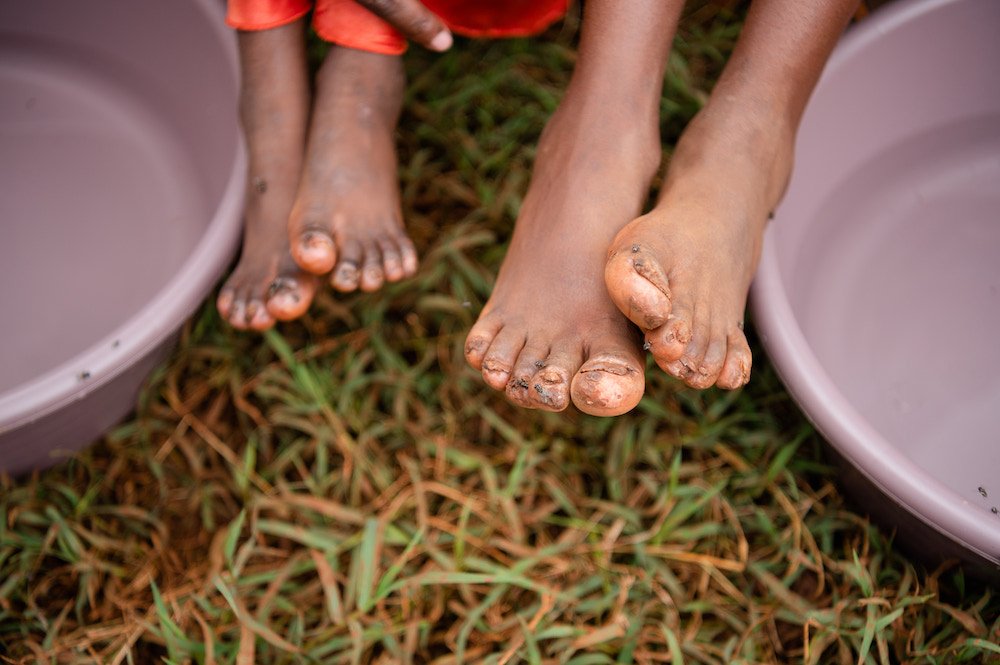What is a jigger sand flea?
A jigger, whose formal name is Tunga Penetrans, is a sand flea commonly found across the Caribbean, Africa, India, Central America and South America.
The difference between jiggers and chiggers
Those living in North America often confuse jiggers with chiggers, which is an insect that can be found in the United States. Chiggers are part of the arachnid family and, while they can be painful, are relatively harmless—jiggers, on the other hand, can cause very harmful short- and long-term effects for those that are impacted by them.
How do jiggers affect humans?
Two children with jigger infestions wait for treatment from Ahadi Kenya Trust and Because International
Both female and male jiggers jump from the ground to land on warm-blooded hosts, including humans, where they bite into the skin and drink the host’s blood. Most often, jiggers attach to feet due to their direct contact with the ground.
Female jiggers go beyond biting and will burrow almost completely into the skin—with only their back end sticking out so it can release eggs. Once burrowed, it looks like a small back dot and typically goes unnoticed.
However, after a few days of feeding and filling with eggs, the jigger gets bigger and the dot grows into a bump that can be itchy and painful to walk on. After two weeks, the female typically releases her eggs and dies, leaving a scab on the skin.
Why are jiggers dangerous?
In areas where clean water and soap aren’t readily available, or for families who cannot afford healthcare, jigger bites can lead to infection from bacteria that gets in through the open wound. Sometimes, if the host’s body is unable to get rid of the jigger’s body after it has died, complications can occur. If untreated, these infections can lead to tetanus, gangrene, limb loss and even death.
In addition to the risk of infection, jigger infestations may be extremely painful to walk on and can cause social stigma in the community—both of which lead to higher rates of school drop-outs, missed work and mental health struggles.
A child’s foot is treated after a jigger infestation
How to treat jiggers
There is no preventative medication for jigger infestations. Once bitten, the risk of infection can be minimized by removing the flea with a sterile needle, followed by treatment of the wound.
Oftentimes, communities that don’t have access to healthcare will try to remove the jigger on their own using unsanitary objects, such as a sewing needle or knife, increasing the risk of infection or the spread of HIV.
Education is needed to help communities understand what jiggers are, how to avoid them and ways to prevent infection. There are organizations out there, such as Ahadi Kenya Trust, who work to increase understanding in areas affected by jiggers.
One method of reducing chances of jigger infestations is to cover areas of the body that are commonly exposed, including the feet.
How to help with The Shoe That Grows
The Shoe That Grows keeps children’s soles protected from jiggers for several years as their feet grow five sizes. By joining The Sole and donating each month, you can provide shoes to children around the world who may be impacted by jiggers.
Resources
“What is a jigger?” Kinship United. https://kinshipunited.org/what-is-a-jigger/.
Bernard Kimani, Josephat Nyagero, and Lawrence Ikamari. “Knowledge, attitude and practices on jigger infestation among household members aged 18 to 60 years: case study of a rural location in Kenya.” The Pan African Medical Journal. 2012; 13(suppl 1): 7.
“What are jiggers?” Sole Hope. https://www.ncbi.nlm.nih.gov/pmc/articles/PMC3589250/.
“Jiggers.” The American Osteopathic College of Dermatology. https://www.aocd.org/page/Jiggers.
:Tungiasis [Tunga Penetrans].” Centers for Disease Control and Prevention. Web. 19 Oct. 2015. https://www.cdc.gov/dpdx/tungiasis/


